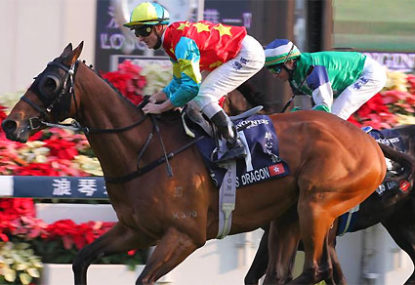TWO GOOD! Zahra wins back-to-back Melbourne Cups on Without a Fight as three horses pull up lame
Without a Fight completed the rare Caulfield Cup-Melbourne Cup double on Tuesday as star jockey Mark Zahra went back-to-back in the big one after…

I have recently returned from a trip to Hong Kong where racing is the king of sport, not just the sport of kings.
In Hong Kong they generally race just two days a week – Sunday at Sha Tin and Wednesday night at Happy Valley. For locals and visitors alike, racing is the thing to do on these days.
The backdrop to Sha Tin race course is the spectacular Ma On Shan Country Park with sweeping mountain views to the east.
Located on the north island, the track is a breeze to get to with an adjacent metro station connected by an overpass.
As the cost of living in Hong Kong is generally lower than Australia, on most race days you can get a hospitality box/balcony seat with international buffet and bar for under AU$50.
My box crowd was predominantly a mix of corporates, owners and Hong Kong nationals.
The TV screens, commentary and general chatter in the box was all in Chinese but when Zac Purton finally got a split on the shortest priced favourite of the day in the seventh race, I heard a piercing “C’mon Zac!” on the balcony. He duly saluted.
Happy Valley race course is set in the heart of Hong Kong Island (south island) and as the races kick off at about 6.15pm, the surrounding streets are jammed packed with city workers and tourists.
Punters arrive at the track on foot, by tour bus, metro and double decker tram, which are generally overflowing.
Serious racing in Hong Kong is held at Sha Tin while night racing at Happy Valley is more for socialising.
Box/buffet seats are in the region of AU$70-$100 and the crowd is nearly all tourists and expats.
I didn’t have any trouble finding another Aussie to share a drink with while swapping stories.
Probably the most interesting thing about Happy Valley is the quirky track. Imagine taking your shoe off and holding it in front of you with the heel the 1,200 metre start, the hole at the 1,000 (slightly indented for 100-200 metres), the bridge at the 2,200 metre start, the toe from the 1,800 to the 1,650 metre starts and the sole as the straight.
According to the China National Tourist Office, the average race day crowd at Sha Tin is almost 50,000 and at Happy Valley 40,000.
Like most things in Hong Kong that run smoothly and efficiently, the venues did not feel crowded.
Course entry is only HK$10 (AU$1.25) and most of the local punters congregate in front of the grandstand to get a close-up glimpse of the horses zipping past.
I was impressed with the number of Hong Kong women that accompanied their husbands, partners, fathers, etc. to the track.
Racing in Hong Kong certainly does capture the imagination of male and female, young and old.
Regular free to air television coverage and limiting racing to two days a week in Hong Kong positions the sport for ‘entertainment’ as well as wagering and helps sustain its future popularity.
Australian racing does the opposite with seven day a week meetings saturating the market and selective free-to-air coverage.
The only legal forms of betting in Hong Kong are on racing, football (predominantly EPL) and the Mark Six Lottery through the Hong Kong Jockey Club (HKJC).
This is despite some illegal bookmaking in the underworld and the government not blocking the websites of overseas bookmakers.
The HKJC says by regulating gambling it is promoting responsible gambling practices among the community.
It says this provides a balance between meeting the demand for gambling and maximising the social and economic benefits for the community, while helping to minimise any potential harm.
According to the HKJC its annual racing turnover in 2005/06 of HK$59 billion (AU$7.37 billion) has increased to HK$84 billion (AU$10.5 billion) in 2011/12.
In 2011/12 the club returned HK$19.06 billion (AU$2.38 billion) directly to the community in duties, taxes, charitable donations and lottery funds.
The landscape is very different in Australia with eight states having individual jurisdiction over numerous betting agencies, hundreds of sports markets, thousands of poker machines and multiple casinos.
Gambling in Australia has come under heavy criticism in recent years for inadequate regulation of poker machines and the infiltration of gambling sponsors into sports journalism.
According to Jacob Saulwick of the Sydney Morning Herald, in 2007/08 the states collected about AU$3 billion from poker machines and AU$4.9 billion from all other forms of gambling (AU$7.9 billion).
This is a substantial resource to put towards educating the public on minimising problem gambling.
I would like to see Australian racing show more initiative towards entertainment value and sustaining the future of the sport by trimming up its product.
We do not need racing every day and with no public holidays or major meetings falling on a Thursday, it would be a logical day for the industry to have off as a start.
Annual prizemoney saved could be provided to regional clubs to strengthen their country cups for possible qualifying races for the Caulfield and Melbourne Cup’s.
The VRC recently announced changes to the Melbourne Cup ballot exemption races, which now must carry Group 1 status and be worth at least AU$1 million.
More entertainment value, better racing products and lower rates of problem gambling in the industry can be led by more co-operation between the state’s racing ministers, the major clubs, the Australian Racing Board and the Australian Jockey’s Association.